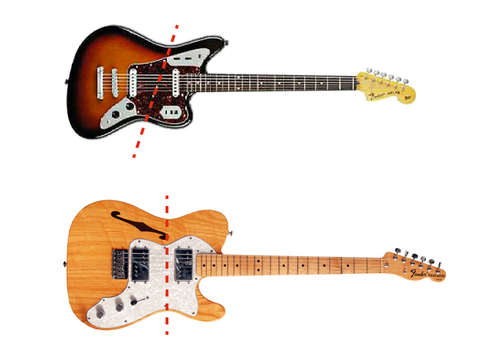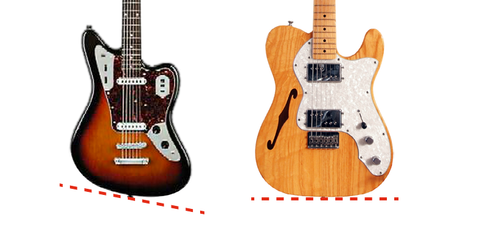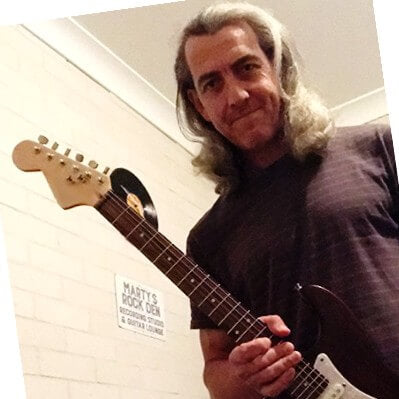Offset Guitar Kits: Build your own DIY instrument
If you have taken even a passing interest in electric guitars, chances are you have heard the term 'offset guitars' in some capacity in recent years.
And, while 'offset’ may seem like the new buzz word in the electric guitar world, the truth is offset guitars have been around for more than 60 years, beginning with the Fender Duo Sonic® in 1956.
The Fender® Offset series, which reintroduced many of these much-loved body shapes to the world in 2016, also served to increase the popularity of offset guitars.
In the following article, we're going to learn how to distinguish an offset guitar, dive into some of the history and show you how you can build your own DIY offset kit guitar.
So if you have been wondering what an offset guitar is, why they remain enduringly popular and how to go about building your own, this article is for you.
What is an offset guitar
While you may see some other qualifying features e.g. short scale length, lightweight body, hardtail bridge, etc. For the most part, an offset guitar is just a way of describing a guitar with an asymmetrical ‘offset’ body shape.
The simplest way to tell them apart from a standard body shape is by taking a closer look at the waist of the guitar. On a standard guitar e.g. a Telecaster® the waist is in perfect alignment (as per the image below). On an offset guitar, the waist is ‘offset’.

Another simple way to tell an offset guitar is by looking at the bottom of the guitar (beneath the bridge). Offset guitars do not typically have a flat bottom as per a more standard body shape.

Over the years the offset body shape has mostly been associated with alternative music. This is largely due to guitarists such as Nirvana’s Kurt Cobain (Fender Mustang®), Sonic Youth’s Lee Ronaldo (Jazzmaster®) and John Frusciante using his Fender Jaguar® on the opening seconds of the now iconic ‘under the bridge’ video clip.
Benefits of Offset Guitars
So why do so many guitarists love offset guitars?
Aside from the popular pastel colors, many are finished in, the fact is an offset body offers a few advantages a regular guitar body doesn’t. This includes:
Comfort
Guitars such as the Fender Jaguar®, Mustang® and Squier J Mascis Jazzmaster® due to their ergonomic design are very comfortable guitars to play.
Much of this is due to the upper waist being moved a few inches closer to the neck of the guitar.
This makes playing in a seated position more comfortable as the guitar is more balanced and can comfortably sit on either leg depending on your preference while maintaining a comfortable position for the forearm of your picking hand.
Shorter Scale Length
While offset guitars are not defined by their scale length, the fact is many of the reissued models do have shorter scale lengths than standard.
A short scale length, means you don’t need to stretch quite as much to play extended and complex chord shapes. Although, for those of us with larger hands they tend to feel a little cramped when playing.
Lightweight Body
Many of the reissued offset guitars are lighter in weight compared to a standard guitar shape. And while the difference may only be slight, consider the fact that when you play the guitar the strap pulls against the back of your neck and can begin to feel heavy if you have been playing in a standing position for any length of time.
Retro Cool
There’s just something about an offset body style. Whether it's due to the history, or the fact that so many indie players love them, the fact is offset guitars give off that ‘retro cool’ vibe like no other guitar body style.
Offset Guitar Kits
If you have wanted to own your own offset guitar but are not particularly thrilled with the idea of paying up to $1300 for a reissue Fender Jaguar® the good news is Guitar Kit World offers a number of offset DIY guitar kits, that are a lot of fun to assemble and allow you to customize the guitar however you like.
MU-style Guitar Kit
The MU-style DIY guitar kit features an offset body shape along with a comfortable ‘C’ shaped neck, 22 frets and 3 x single-coil pickups with 1V, 1T, 5-Way selector switch: Check out the MU DIY Guitar Kit.
JG-style Guitar Kit
The JG DIY guitar kit, also features an offset body style along with replica hardtail bridge and renowned smooth tremolo system.
Featuring 2 x Humbucker pickups and pickup switching system, the JG is another great option for those interested in offset style guitars: Check out the JG DIY Guitar Kit.
FB-style Guitar Kit
While technically a ‘reverse offset’ body style the FB DIY Guitar Kit is another interesting option for guitarists looking for a non-standard body shape.
FB-style guitar kits feature 2 x mini-humbucker pickups, 2V, 2T and 3-Way pickup switch along with reverse offset body.
As per all custom kit guitars, you can select your body timber, neck timber and fretboard material allowing you to customize the look and feel of the guitar to your own specifications.
Summary: Everything Old is New Again
Unlike many other industries, electric guitar design doesn’t tend to change all that much over time. If you need an example, compare automobile design in the ’60s to today and then consider how little electric guitars have changed in that time.
The fact is, when you are onto a good thing, there’s no need to throw out the baby with the bathwater.
That’s certainly the case with offset guitars, and love them or hate them one thing is for sure, they are unlikely to change in the foreseeable future.



